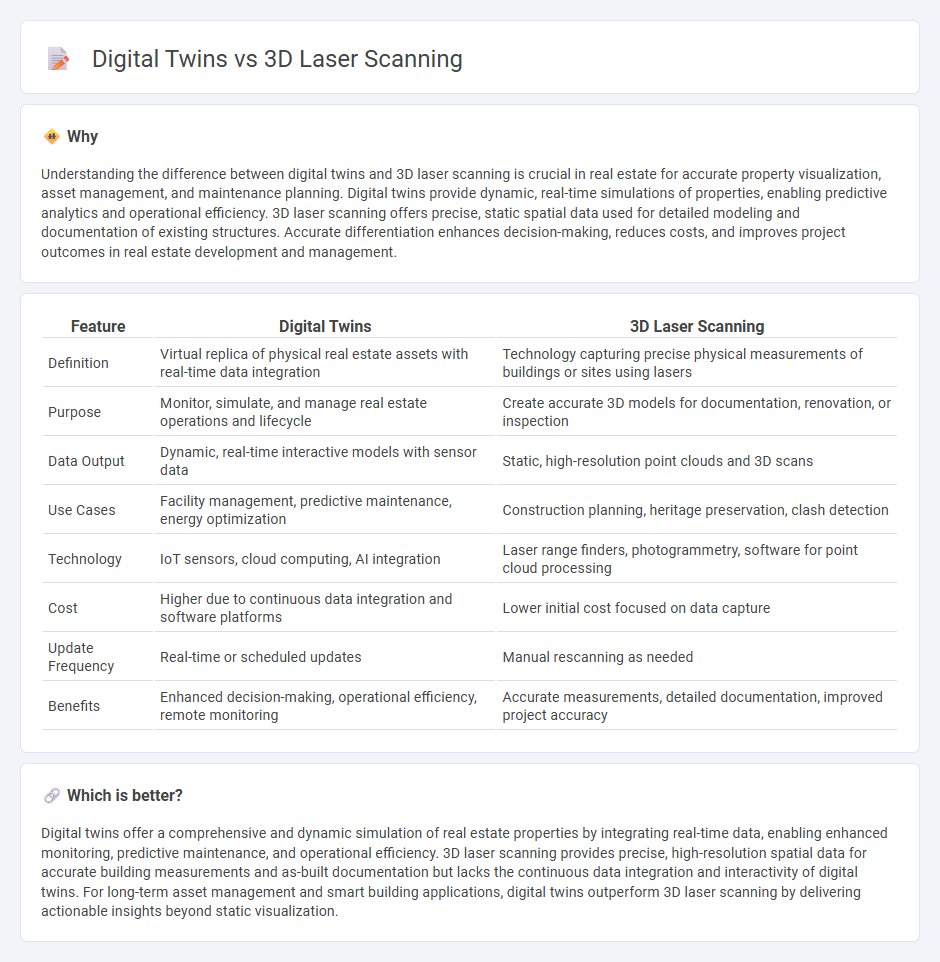
Digital twins create dynamic virtual replicas of real estate properties for continuous monitoring and simulation, enhancing asset management and operational efficiency. 3D laser scanning captures precise spatial data to generate accurate, high-resolution models used in design, renovation, and documentation processes. Explore how these advanced technologies revolutionize real estate development and property management.
Why it is important
Understanding the difference between digital twins and 3D laser scanning is crucial in real estate for accurate property visualization, asset management, and maintenance planning. Digital twins provide dynamic, real-time simulations of properties, enabling predictive analytics and operational efficiency. 3D laser scanning offers precise, static spatial data used for detailed modeling and documentation of existing structures. Accurate differentiation enhances decision-making, reduces costs, and improves project outcomes in real estate development and management.
Comparison Table
| Feature | Digital Twins | 3D Laser Scanning |
|---|---|---|
| Definition | Virtual replica of physical real estate assets with real-time data integration | Technology capturing precise physical measurements of buildings or sites using lasers |
| Purpose | Monitor, simulate, and manage real estate operations and lifecycle | Create accurate 3D models for documentation, renovation, or inspection |
| Data Output | Dynamic, real-time interactive models with sensor data | Static, high-resolution point clouds and 3D scans |
| Use Cases | Facility management, predictive maintenance, energy optimization | Construction planning, heritage preservation, clash detection |
| Technology | IoT sensors, cloud computing, AI integration | Laser range finders, photogrammetry, software for point cloud processing |
| Cost | Higher due to continuous data integration and software platforms | Lower initial cost focused on data capture |
| Update Frequency | Real-time or scheduled updates | Manual rescanning as needed |
| Benefits | Enhanced decision-making, operational efficiency, remote monitoring | Accurate measurements, detailed documentation, improved project accuracy |
Which is better?
Digital twins offer a comprehensive and dynamic simulation of real estate properties by integrating real-time data, enabling enhanced monitoring, predictive maintenance, and operational efficiency. 3D laser scanning provides precise, high-resolution spatial data for accurate building measurements and as-built documentation but lacks the continuous data integration and interactivity of digital twins. For long-term asset management and smart building applications, digital twins outperform 3D laser scanning by delivering actionable insights beyond static visualization.
Connection
Digital twins in real estate leverage 3D laser scanning technology to create precise, virtual replicas of physical properties, enabling detailed visualization and analysis. This integration enhances building management, facilitates renovation planning, and improves decision-making by providing real-time, accurate data on structural and spatial conditions. Real estate developers and asset managers benefit from reduced costs and risks, alongside improved efficiency throughout the property lifecycle.
Key Terms
Point Cloud Data
3D laser scanning captures precise point cloud data, creating detailed spatial representations crucial for digital twin development. Digital twins leverage this data to simulate real-world environments, enabling enhanced monitoring, analysis, and predictive maintenance. Explore how integrating point cloud data into digital twins drives innovation in industries like construction and manufacturing.
BIM (Building Information Modeling)
3D laser scanning captures precise spatial data of existing structures, enabling accurate as-built BIM models that enhance project planning and facility management. Digital twins extend BIM by integrating real-time sensor data and analytics to simulate, monitor, and optimize building performance throughout its lifecycle. Explore how combining 3D laser scanning and digital twins revolutionizes BIM workflows and asset management strategies.
Spatial Accuracy
3D laser scanning delivers highly precise spatial data by capturing millions of accurate points in real-world environments, often achieving millimeter-level accuracy critical for detailed site surveys. Digital twins integrate this 3D scan data with real-time sensor inputs and IoT connectivity, enabling dynamic spatial accuracy updates to reflect current conditions. Explore how these technologies complement each other to optimize spatial accuracy in modern infrastructure and industrial applications.
Source and External Links
What is laser 3D scanning? - Artec 3D - Laser 3D scanning captures precise 3D information of objects or environments by emitting laser pulses that reflect back to sensors, measuring distance via time-of-flight to create detailed point clouds for 3D modeling and analysis.
3D Laser Scanning | Benefits & How It Works - Autodesk - 3D laser scanning uses laser beams to measure accurate distances rapidly, producing dense point clouds to create detailed models used in architecture, engineering, and historical preservation for precise decision-making.
3D scanning - Wikipedia - 3D scanning collects three-dimensional data about an object's shape using various technologies including laser scanning, which uses low-power lasers to digitize surfaces for applications from entertainment to industrial design and quality control.
 dowidth.com
dowidth.com